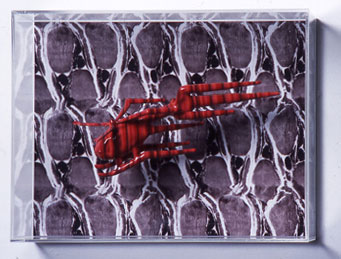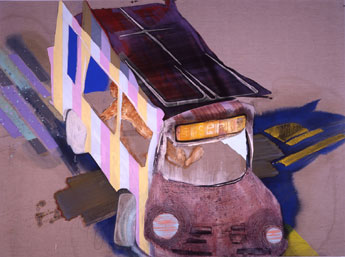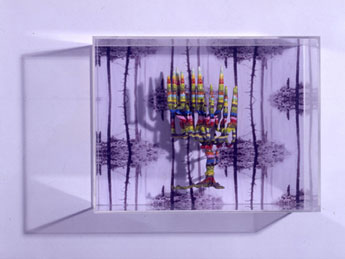"OBJECTS
OF DESIRE"
Says
Bradford:
 "The
work is generated often as a response to western urban culture: advertising,
signage, the graphic image, the Media, and the structures that these entities
impose upon modern life.
"The
work is generated often as a response to western urban culture: advertising,
signage, the graphic image, the Media, and the structures that these entities
impose upon modern life.
Advertising aims to create desire, it then offers the means of sating
that desire. Prolonged exposure to advertising can create false desire
and frustration when the means to sate that desire is unobtainable. The
work I make provides me with a platform to reclaim control over this persuasive
tide of emotional implants.
I
have two practices running in tandem, the first is large-scale 2D oil
painting on un-primed linen. The second involves dipping 3D objects repeatedly
in household gloss paint. These small-scale sculptural pieces are often
accompanied by various mixed media, including photography, digital imagery
and lighting effects.
Through
painting, the modern bombardment of graphic imagery is assimilated, manipulated,
upgraded and regurgitated as a means to rest back control of my desires.
The work forms a resistance to the empty promises of 'objects of desire'
and lifestyle choices that are not my own. Paradoxically the work becomes
an 'object of desire' in itself, but one born of my own free will and
with added content and meaning.
Imposing
societal structures such as advertising are mocked, dislodged, and replaced
with self-initiated structures that then form a physical and emotional
template for my work.
This
process is evident in my 'dipping' method. Retail objects or 'ready-mades'
undergo a metamorphoses aimed at replacing their original meaning with
an ambiguous meaning of my own making. Their function is denied, their
surface signifiers replaced with colour and seductive uses of paint.
With
2D painting it is 'narrative' which under-goes a metamorphosis. A specific
readable narrative is absolved of its functional duties and replaced with
an abstracted narrative. The abstracted image left behind is used as a
shell, a shape, a compositional template that allows an abstracted painting
to evolve.
With
the Television pieces the 'static' produced when the TV is switched on
but not tuned in becomes a metaphor for the shut down of free will - the
coma induced by nutrient deficient culture and imagery.
Both
disciplines are linked further by the use of layering, or a process better
described as creating 'strata'. The build up of paint over a period of
time in layers is employed on the paintings surface or in the action of
repeated ' dipping in order to sometimes conceal, sometimes reveal. A
striated surface acknowledges the passing of time and mirrors another
preoccupation: movement (the combination of time and space creates movement).
Striation reveals a works history and acknowledges its place as a finite
object in time.
The
subversion of given realities brought about by the successful use of visual
illusion is also dealt with in my work. A paintings inherent limitations
of being inanimate, flat, and material, are another source of amusement
for me. I like to mock these limitations by playing visual games with
the paintings edges.
I
make complex works in the simplest way. My work ackowledges an artwork's
capacity to be both meaningless and profound".
Shumon
Basar writes:
"Shane
Bradford follows in a long tradition of 20th century painters
enamoured with post-Pollock paint drips. But Bradford enacts his painterly
fetish with one vital spelling difference: drip becomes dip.
He
has been methodically and insistently dipping objects in sequences of
technicolour emulsion. Lollypop stick, baby's dummy, Paul Smith toothbrush,
toy car and spoon. Each is subjected to a precision process which eventually
renders the original object an ossified version of itself, seemingly
appended by a thick drip of still, concentric paint.
The
geometric, graphic compositions that the paint assumes upon the objects
is literally only the surface of one's desire towards them. As you may
have
noticed, the pre- and post- dip objects have connotations of oral usage.
Add
to this the shiny, gelatinous disposition of the juicy colours, and
Bradford's painted objects seem literally good enough to eat. 'I like
you so
much...mmm...I want to eat you!'
Bradford's
luscious, sweet objects employ paint to remind us that desire is
an index of mortality. Eat this, sate your desire, and be prepared to
pay
the price for your pleasure principle."
Shane's
paintings and object-based works were brought to our attention by one
of our arts consultants, Mark Thompson, who is also curator for the show.

.jpg)
.jpg)

.jpg)

.jpg)

.jpg)
.jpg)
.jpg)
.jpg)
